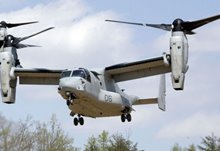A Combat Mission Two Decades in the Making
 By Renae MerleWashington Post Staff WriterSaturday, April 14, 2007; D01
By Renae MerleWashington Post Staff WriterSaturday, April 14, 2007; D01After more than 20 years in development at a cost of billions of dollars, the long-troubled V-22 Osprey will head to Iraq in September for its first combat missions, the Marine Corps said yesterday.
The tilt-rotor Osprey, a helicopter-airplane hybrid, has survived attempts by the Pentagon leadership to cancel it, criticism of its rising cost and unique design, and three fatal accidents since 1992. The aircraft, made by Bell Helicopter and Boeing, can take off, land and hover like a helicopter, then turn its rotors to fly straight ahead like a conventional plane. It will operate out of al-Asad air base in central Iraq for seven months.
"The story of how we got here is a long one," Gen. James T. Conway, the Marine Corps commandant, said at a morning news conference at the Pentagon. "I'll just say that the quantum leap in technology that this aircraft will bring to the fight has been a road marked by some setbacks, lots of sacrifices and the success of these Marines standing before you today."
A report in 1983 by the Pentagon's office of program analysis and evaluation concluded that the plane's concept was flawed. In the late 1980s and early '90s, Dick Cheney, the Defense secretary at the time, tried to cancel it. The aircraft's three fatal crashes -- one in 1992 and two in 2000 -- killed 26 Marines and four civilians. In 2001, allegations emerged that maintenance records for the aircraft had been falsified, which the commander of the Osprey's maintenance squadron later admitted was done to make the aircraft appear more serviceable than it was. The Osprey fleet was briefly grounded this year after the military found a glitch in a computer chip that could cause the aircraft to lose control. >>>cont
LinkHere





0 Comments:
Post a Comment
<< Home